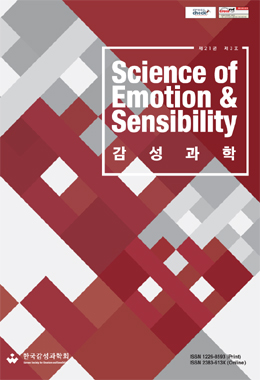스트레스는 자율신경계 반응의 변화를 수반하며, 특히 심박변이도 지표는 스트레스에 의한 자율신경계의 활동을 반영하는 양적 지표로 사용된다. 본 연구에서는 스트레스 완화를 위한 산소와 색채 조명의 복합 자극이 제시되는 동안 자율신경계 반응의 변화를 확인하였다. 42명의 실험참가자는 지난 2주 동안 경험한 스트레스에 대한 증상들을 스트레스반응 척도에 평가하였다. 스트레스 평가 후, 실험참가자는 복합 자극을 제시받았고, 자극 제시 전과 후, 그리고 자극이 제시되는 동안 심전도 신호가 기록되었다. 자극 조건은 30% 농도의 산소와 백색 조명, 산소와 주황색 조명과 산소와 파란색 조명의 조합의 세 가지로 구성되었다. 심박률(HR), R-R간격의 표준편차(SDNN), 연속한 R-R 간격 차이 값의 평균제곱근(RMSSD)과 심박변이도의 저주파 성분(LF), 고주파 성분(HF), 그리고 LF와 HF의 비율을 심박변이도 지표로 추출하였다. 이들 지표는 자극 제시 전과 후의 평균을 비교하는데 활용되었다. 결과는 자극 조건이 제시되고 난 후, HR과 LF/HF ratio의 유의한 감소를 보여주었다. 특히, 산소와 파란색 조명이 제시된 조건에서 다른 두 조건보다 유의하게 큰 RMSSD와 HF의 증가 및 LF/HF ratio의 감소가 나타났다. 이는 30% 농도의 산소와 파란색 조명의 조건이 부교감신경의 활성화에 의한 자율신경의 균형을 유발하여 스트레스 이완에 가장 효과적임을 보여주었다.
Stress is accompanied by changes in the responses of the autonomic nervous system, and the heart rate variability (HRV) index is a quantitative marker that reflects autonomic responses induced by stressors. In this study, we observed changes in the autonomic responses induced by combinations of 30% oxygen administration and color light for stress relaxation. In all, 42 participants produced stress symptoms over the preceding two weeks, as rated on the stress response scale. After stress assessment, they were exposed to three therapeutic conditions, and electrocardiogram (ECG) signals were recorded before, during, and after therapy. The three therapy conditions consisted of only 30% oxygen administration with white light, a combination of 30% oxygen and orange light, and a combination of 30% oxygen and blue light. The HRV indices extracted from ECG signals were heart rate (HR), the standard deviation of the RR interval (SDNN), the mean square root of consecutive RR interval difference values (RMSSD), the low frequency component of HRV (LF), the high frequency component (HF), and the LF/HF ratio. These indicators were used to compare mean values before and after therapy. The results showed that HR and the LF/HF ratio were significantly lower after therapy than before it. In particular, the condition with 30% oxygen and blue light yielded significantly greater RMSSD and HF increases, as well as decreases in LF/HF ratio than in other two conditions. Our results suggest that therapy with 30% oxygen and blue light is the most effective for the relaxation of stress, which implies autonomic balance by parasympathetic activation.


